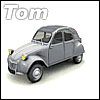tp wrote:
On the subject of G-Forces, I wonder if someone could clear this up for me - Are lateral G-forces negative and longitudinal G-Forces positive? I've wanted to know this for some time.
I’ll try

The concept of positive/negative G you are thinking about, as Dave said, is conventional and related mainly to effects on human body.
In aeronautical terms positive G is by definition when the normal (= perpendicular) mass forces applied to the airplane are in the direction going from upper side of the wing to lower side of the wing (pull the bar and you have positive acceleration).
That means that in reference to human body positive accelerations are the ones causing the blood to go from head to feet, negative ones cause blood to go from feet to head; for various physiological reasons human resistance to positive accelerations is lot higher than to negative ones.
Think about an elevator, it’s the typical example. When it starts to go up you have positive acceleration on your body, when on the contrary it starts to go down you have negative acceleration on your body; if you pay attention you’ll notice that, although acceleration is minimal, the negative one is a bit more disturbing.
Obviously you have always to consider while talking about effects on body, besides the intensity, also the duration of the force application, hence of the acceleration.
Thinking now about the car, for lateral acceleration is pointless to make a distinction (unless you need to decide, as for example while using accelerometers for data logging, that left is positive and right negative or viceversa but it’s purely convention), while longitudinal are judged in physics terms, increment of speed is positive acceleration, reduction of speed is negative.
Thinking in aeronautical conventional term, for the driver, given the driving position, the deceleration (up to 5g) causes to the body what is a positive acceleration (blood from head to feet), while negative, blood from feet to head, is for car acceleration, rate lot lower, less than 2 g. Fortunately I would say, because if they were lying down with head at the front of the car the situation would be reversed and they would have a very hard time to cope with 5g negative so many times during a race.
Hope I didn’t increase your confusion.




